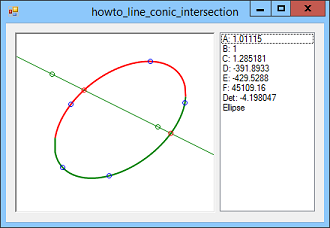![[C# Helper]](../banner260x75.png)
|
|
 |
![[Beginning Database Design Solutions, Second Edition]](db2_79x100.png)

Title: See where a line intersects a conic section in C#
This example shows how you can see where a line intersects a conic section. You can use the more general method described in the post See where two conic sections intersect in C#. This example takes advantage of the simpler equation for a line to calculate solutions directly instead of relying on Newton's method (or binary subdivision) to approximate the solutions. Left-click to select five points that define a conic section. See the example Select a conic section in C# for information about how that works. Right click to select two points that define the line. When you have selected a conic section and a line, the program draws them and their intersections. Here's the math that makes it work. The parameterized equation for a line segment through the points (x1, y1) and (x2, y2) is: 

The general equation for a conic section is: 
If you plug the equations for the line into the equation for the conic section, you get: 





That's all there is to it! The example program uses the following code to find the intersection between a conic section with coefficients A, B, C, D, E, and F, and the line containing the points pt1 and pt2.
// Find the points of intersection between // a conic section and a line. private List<PointF> IntersectConicAndLine( float A, float B, float C, float D, float E, float F, PointF pt1, PointF pt2) { // Get dx and dy; float x1 = pt1.X; float y1 = pt1.Y; float x2 = pt2.X; float y2 = pt2.Y; float dx = x2 - x1; float dy = y2 - y1; // Calculate the coefficients for the quadratic formula. float a = A * dx * dx + B * dx * dy + C * dy * dy; float b = A * 2 * x1 * dx + B * x1 * dy + B * y1 * dx + C * 2 * y1 * dy + D * dx + E * dy; float c = A * x1 * x1 + B * x1 * y1 + C * y1 * y1 + D * x1 + E * y1 + F; // Check the determinant to see how many solutions there are. List<PointF> solutions = new List<PointF>(); float det = b * b - 4 * a * c; if (det == 0) { float t = -b / (2 * a); solutions.Add(new PointF(x1 + t * dx, y1 + t * dy)); } else if (det > 0) { float root = (float)Math.Sqrt(b * b - 4 * a * c); float t1 = (-b + root) / (2 * a); solutions.Add(new PointF(x1 + t1 * dx, y1 + t1 * dy)); float t2 = (-b - root) / (2 * a); solutions.Add(new PointF(x1 + t2 * dx, y1 + t2 * dy)); } return solutions; } This method simply plugs its parameters into the equations shown earlier. Depending on the value of the determinant, the method adds 0, 1, or 2 points to the the solution list and returns the solutions. Download the example to experiment with it and to see additional details. |
![[Beginning Software Engineering, Second Edition]](book_sw_eng2_79x100.png)
![[Essential Algorithms, Second Edition]](book_algs2e_79x100.png)
![[The Modern C# Challenge]](book_csharp_challenge_80x100.jpg)
![[WPF 3d, Three-Dimensional Graphics with WPF and C#]](book_wpf3d_80x100.png)
![[The C# Helper Top 100]](book_top100_80x100.png)
![[Interview Puzzles Dissected]](book_interview_puzzles_80x100.png)
![[C# 24-Hour Trainer]](book_csharp24hr_2e_79x100.jpg)
![[C# 5.0 Programmer's Reference]](book_csharp_prog_ref_80x100.png)
![[MCSD Certification Toolkit (Exam 70-483): Programming in C#]](book_c_cert_80x100.jpg)
